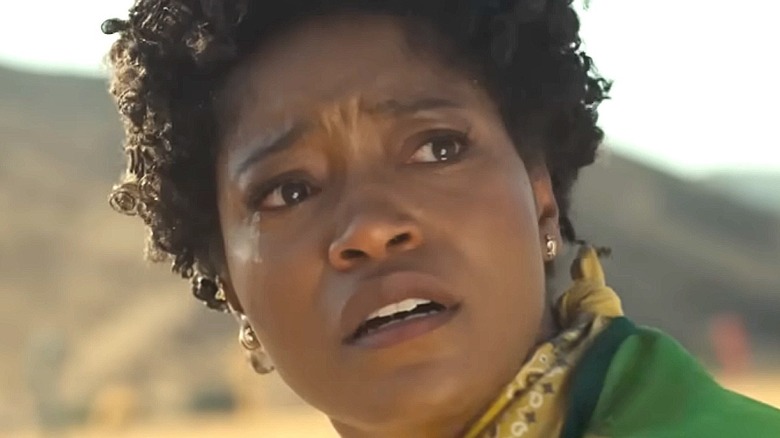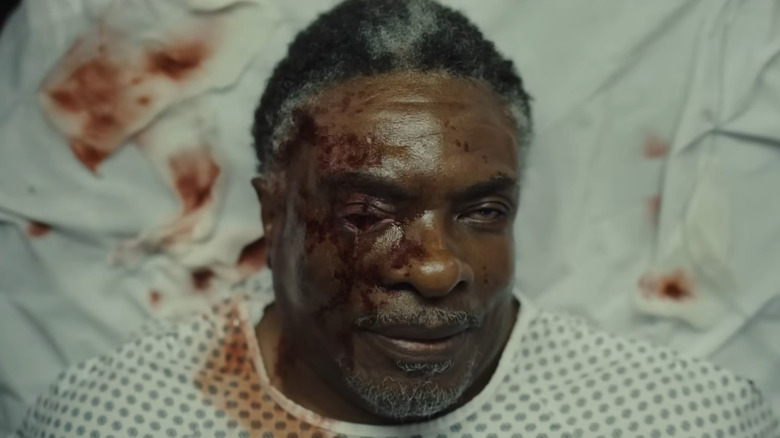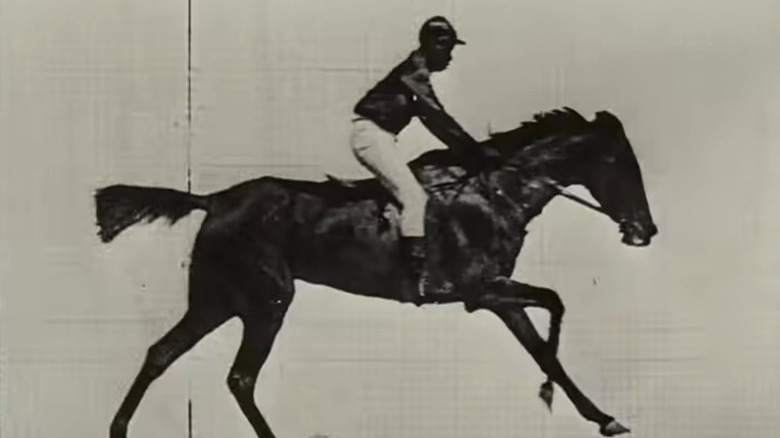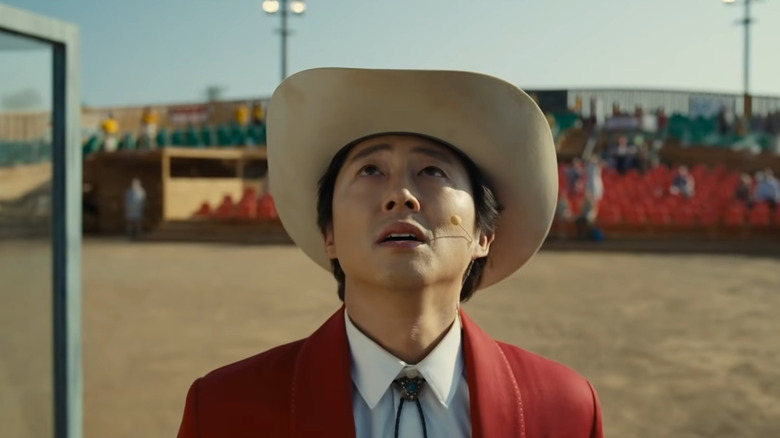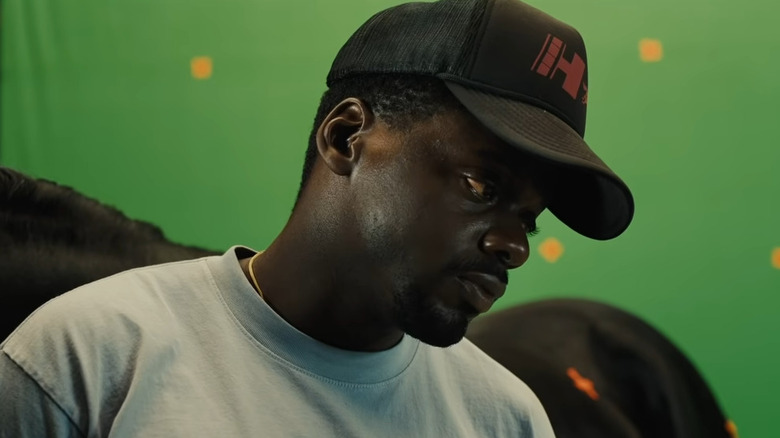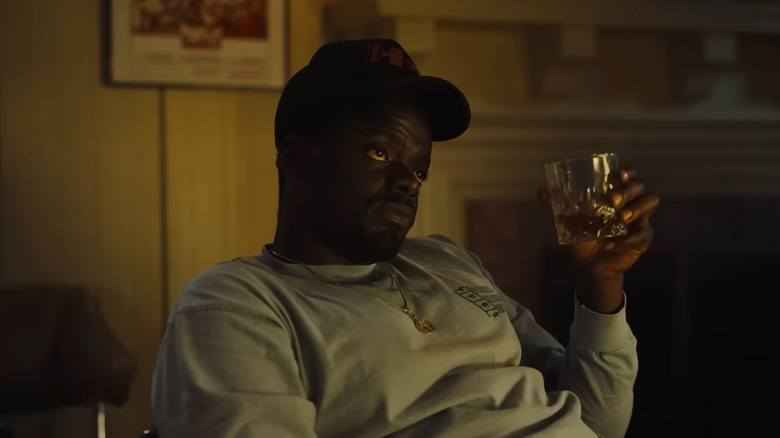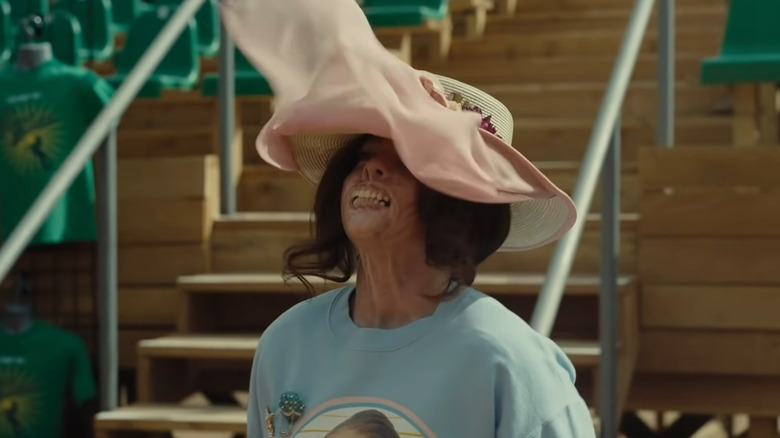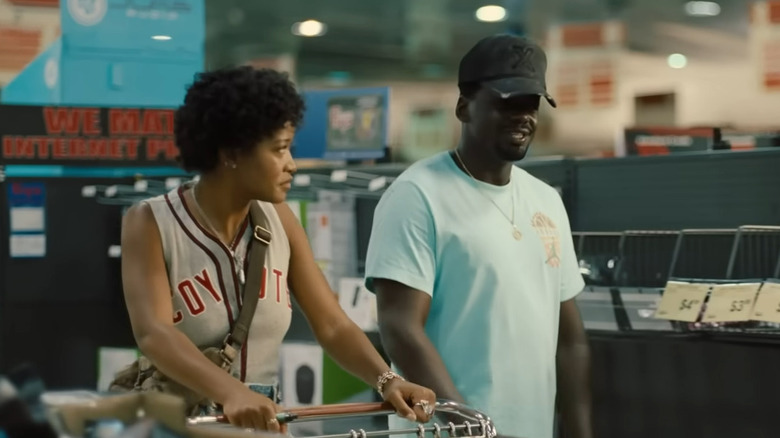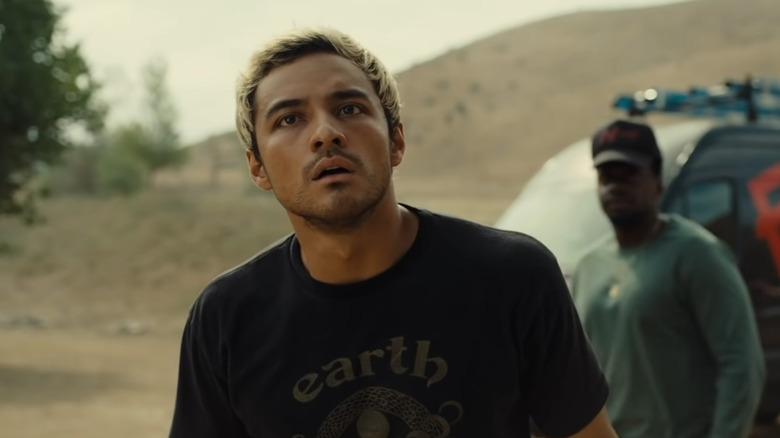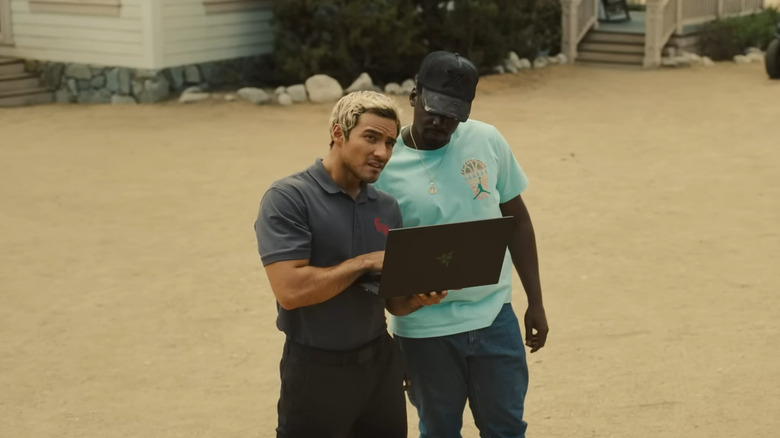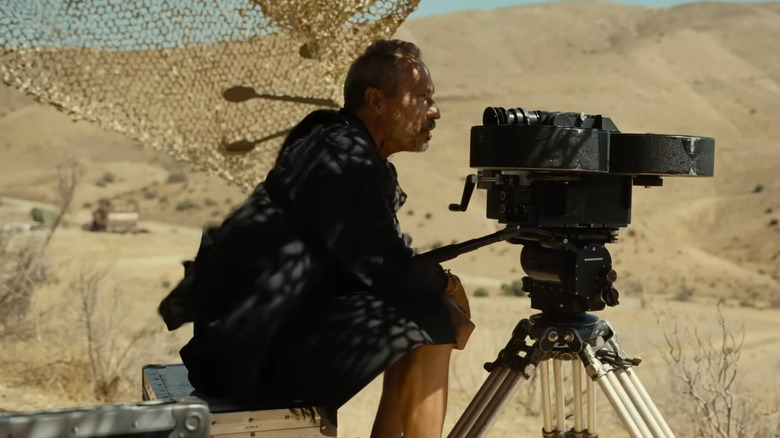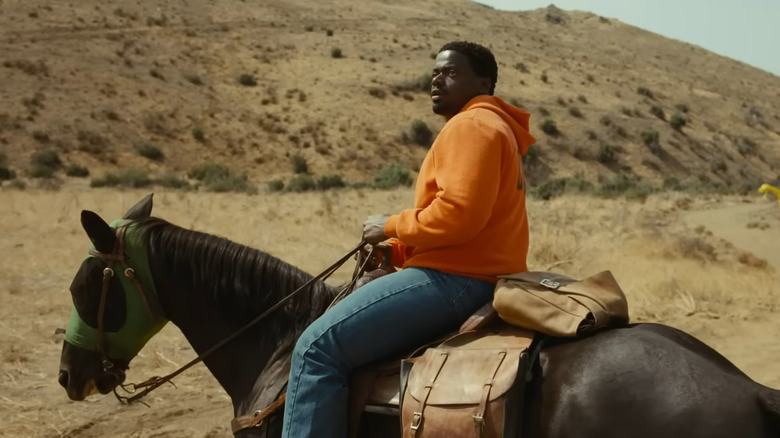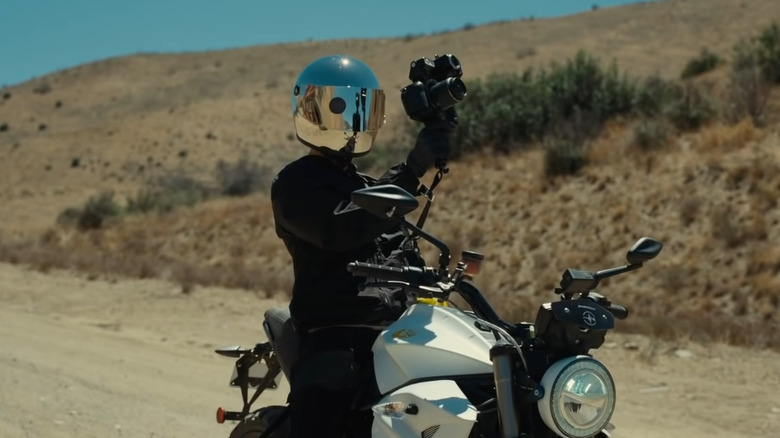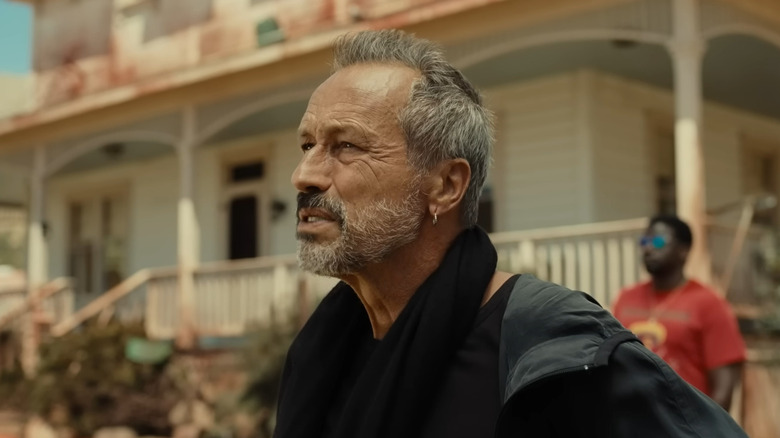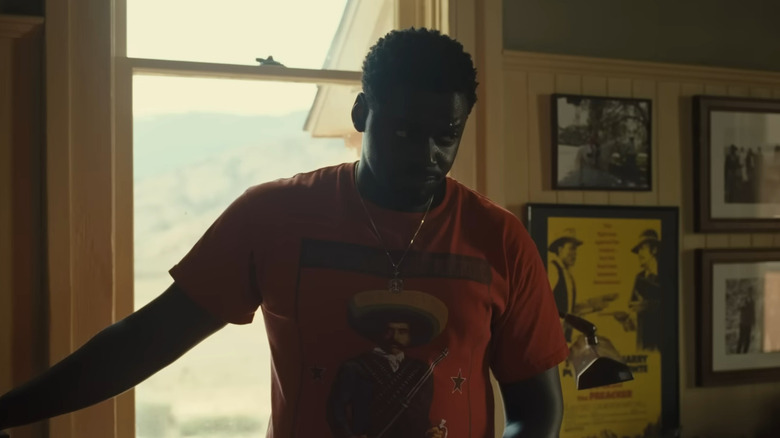Confusing Moments In Nope Explained
There's a lot to process in Jordan Peele's "Nope." The sci-fi horror film takes major cues from classics like "Close Encounters of the Third Kind," "Alien," and "The Shining," embracing an enigmatic take on the old UFO formula that keeps things feeling fresh. The movie has received high praise from critics, with particular props given to its visual flair and sense of suspense. It's a film with a lot of moving pieces, and figuring out how they all go together is a big part of the fun.
Of course, to keep a mystery tense, you have to obfuscate, and Peele is a master at this. "Nope" is loaded with brief shots and throwaway lines that actually hold special significance to the plot, but you probably won't grasp that deeper meaning your first time through. It's the kind of movie that will have you saying "ohhhhh" a lot on your second viewing, and probably even on your third. That's because while a lot of the little touches in the film can be pretty baffling, they're all tied together in an intentional way.
Here are some of the most confusing moments in "Nope" explained.
The death of Otis Haywood
After a pretty unsettling opening shot of a bloodied chimpanzee in a birthday hat (more on that later), "Nope" introduces OJ Haywood (Daniel Kaluuya) and his father Otis (Keith David). The two run a horse ranch with a side business of wrangling the animals for Hollywood films, and their intro scene starts off pretty quiet and peaceful. That is, until an array of objects start raining from the sky like daggers — one of which fatally wounds Otis.
This scene is pretty clearly explained via the later events of the film, but it can be a bit confusing at first. While OJ is told by the authorities that the items likely fell out of an airplane, he doesn't really buy that explanation. Eventually, he discovers that a giant alien monster is to blame — a creature that vomits out any non-organic material after feeding. So, presumably, the alien was passing overhead after a meal, cloaked in its cloud cover, and arbitrarily decided to spit up some keys and coins directly over the Haywood ranch.
Of course, this begs the question of who the alien ate previously, which is never addressed. It's also curious to note that Otis' death marks the creature's first appearance, as Ricky Park (Steven Yeun) later says that he first saw the UFO right around the same time. So maybe the projectile-vomiting is more intentional than it seems. Maybe the alien decides it wants the ranch to be its new home and attacks accordingly.
The opening credits sequence
Following the brutal opening combo of "Gordy's Home" and Otis' death, "Nope" launches into a full opening credits sequence — something seen less and less in modern movies but common to the classic genre flicks that Peele pulls from. The only thing is, it's hard to tell exactly what's going on during the opening credits. The names appear in the middle of an oscillating landscape of waves, almost like the viewer is sitting inside an otherworldly blanket fort. Eventually, the camera zooms in to reveal a man riding a horse — a clip later explained to be the first movie ever made.
It's basically impossible to discern what's happening your first time watching the "Nope" opening credits, but after going through the full film, it becomes much clearer. The camera shot that displays the credits is the same shot used to show the inside of the alien's mouth later on. The flags from the decoy house are repeatedly shown dangling out of the billowing maw, and the shot is used again in the Star Lasso Experience scene when the creature devours a whole show's worth of people.
This could just be a fun (and creepy) Easter egg for folks on their second viewing, but it can also be read as thematically significant. Rattling off the cast and crew from the perspective of the monster is an interesting choice, and the texture of the alien also foreshadows its final form.
OJ's meeting with Ricky Park
After getting kicked off a film set because of the incompetence of others, OJ and Emerald head to the Wild West theme park Jupiter's Claim, owned by the enigmatic Ricky Park. Specifically, OJ goes there to sell another horse — Lucky — to Ricky, having already sold him almost a dozen. While in the meeting, OJ brings up the notion of buying a few of the horses back, which causes Ricky to pause and eventually change the subject.
This scene makes a lot more sense with the context of the rest of the movie. It's implied that Ricky has been experimenting with the alien for some time by feeding it horses — a grim act that eventually becomes the centerpiece of his Star Lasso Experience. Ricky probably balks at the idea of selling OJ the horses back because, well, they're not around any more.
Instead of really discussing the issue, Ricky switches gears and tells Emerald all about his experience shooting the sitcom "Gordy's House" — the site of the violent incident pictured in the first scene. This moment also foreshadows the Star Lasso Experience, as it shows Ricky's ability to ignore trauma and potential danger in the interest of turning a profit.
OJ's fake alien encounter
After setting up security cameras all around the ranch and preparing for the UFO's return, OJ has what seems at first to be a real alien encounter in the horses' stables. While investigating some strange activity, he comes upon three big-headed beings covered in coarse black hair and tries to get a decent picture. It's one of the film's spookier scenes, but it ends up being a complete fake-out, as the "aliens" are nothing more than three kids in costumes.
Specifically, they're implied to be the children of Ricky Park, showing up later on in the same costumes to perform at the Star Lasso Experience. After their cover is blown, they tell OJ not to mess with Jupiter's Claim and quickly leave. This is presumably all because Emerald stole one of the park's horse statues, but there might be more at play than simple recompense.
It's suggested at various points that Ricky is interested in purchasing the whole Haywood ranch. Given that his newest business venture involves chasing down a UFO that lives in the area, that makes a lot of sense. Because Ricky and his whole family get eaten soon after the fake alien encounter, this plotline is abruptly cut off, but it's possible that the kids' prank would have been just the start of a campaign to compel OJ to sell. Businessmen using skeevy tactics to force people to sell property is a classic Western trope, and it feels right at home in "Nope."
The Gordy's Home tragedy
Despite the fact that "Nope" is really an alien movie, the film repeatedly returns to a seemingly non-alien incident — the chimpanzee rampage at the 1998 "Gordy's Home" taping. The incident looms large over the whole movie, but even when the full flashback is shown, some details remain a bit fuzzy.
The ape playing Gordy isn't shown on screen until after he becomes violent, which means that the exact trigger for his rage isn't entirely clear. The last thing that happens before he goes ballistic is the release of the birthday balloons, which could have been a kind of sensory trigger, but that isn't confirmed.
Whatever the real instigating event is, "Nope" implies that the folks on set are really the ones to blame for the incident. OJ shows repeatedly how slow, deliberate, and respectful care is necessary to effectively handle animals on set, and the film also makes a point of showing that one stupid move from an uneducated person can set an animal off. In reality, the chimp playing Gordy was probably suffering from a buildup of poor care and sensory overload, all leading to an explosive moment.
He goes after the actor playing the mother first and brutally beats her to death, and he goes after the father's actor next. It looks like the chimp has a much better rapport with Ricky, but animal control agents (or the police) arrive and kill the ape before that can be proven.
Who's the woman at the Star Lasso Experience?
One person who does survive the "Gordy's Home" tragedy is Ricky's co-star Mary Jo — the actor who played his sister on the sitcom. It's easy to miss this detail, though, as she's only briefly shown on screen before getting sucked into the alien maw.
While introducing the Star Lasso Experience, Ricky gives Mary Jo a special shout-out and oddly mentions that she was his "first crush." A woman is then shown sitting in the audience with a veil covering her face. At this point, the true nature of the UFO remains unclear, so it's easy to read Mary Jo as having some kind of extraterrestrial involvement. It looks for a while like Ricky might be involved with the alien in more complicated ways, but that all ends up being a red herring after the monster devours him and his guests.
Because the whole scene goes by so fast, Mary Jo's presence can be a bit confusing, especially since she isn't named previously. But if you take a look at the shirt that she's wearing at the Star Lasso Experience, you'll notice that it has her old character's face on it. The facial scars revealed when her veil blows are presumably the result of her encounter with the chimpanzee as a child. Tragically, she ends up dying due to another "show animal" deciding that it's had enough.
What do the chapter titles mean?
"Nope" breaks up its story into several smaller chapters, each of which is heralded by a stark title card. The chapter names each correspond to one of the animals (counting the alien as an animal) involved in the story: Ghost, Clover, Gordy, Lucky, and Jean Jacket. However, their significance goes a couple of layers deeper.
Most of the animals named in the chapter titles get killed in their respective chapters. Ghost and Clover are the first horses OJ sees get sucked up by the alien. In the Gordy chapter, we finally see the bloody end to the eponymous chimpanzee's on-set attack. And by the end of the Jean Jacket chapter, the alien is laid to rest by Emerald and a giant Kid Sheriff balloon. The only animal not to die in their chapter is Lucky, who — you guessed it — gets lucky and survives.
Additionally, the chapter breaks introduce a nice pacing element to the film. Old UFO movies often focus on specific raids, and by segmenting "Nope" in that same way, Peele both evokes the genre's past and adds a methodical kind of momentum to the film. Each chapter tells a relatively independent story of a particular encounter, with "Gordy" being the only one that isn't alien-related. This structure really drives home the hunting pattern of the monster, which plays into all the overarching animal themes.
Raining blood on the ranch
Arguably the most graphic and striking scene in all of "Nope" happens after the alien eats the people at the Star Lasso Experience. Whether seeking more prey or simply trying to return home, the creature descends directly over the Haywood house and begins releasing all manner of objects. Coins, keys, and a giant statue of a horse all get jettisoned out of the creature's maw, but it also spews a veritable hailstorm of blood and viscera from its recently consumed meal. In other words, the alien starts raining literal blood over the Haywood house.
The spark for this horrifying moment is clearly the alien's feast at Jupiter's Claim. It sucks up way more people and other assorted items than ever before, so it makes sense that it's, uh, release, ends up being so massive. Why it chooses to dump all over the Haywood house specifically, however, is a bit less clear. Is the alien trying to urge Angel, OJ, and Emerald out into the open where it can eat them? Is it a show of ownership? Or does it legitimately just think that the house is an ideal bathroom? The best explanation is probably OJ's own — it's a territorial animal, and it's laying a claim to the ranch.
Why does OJ keep going back to the ranch?
Despite being one of the two lead protagonists of "Nope," OJ Haywood doesn't get a ton of overt character development. He's a quiet and solitary man who seems to prefer the company of horses to that of humans, but he also doesn't seem to love the Hollywood work that his father pushed him into. He tells Emerald early on that he's considering selling the ranch, which implies he'd be happy doing something else, but he also never actually says that he intends to do so. Even UFO attacks and raining blood barely get a rise out of OJ, who willingly returns to the ranch time after time despite the inherent danger.
Why does OJ do this, knowing that he could get abducted and devoured? Part of it seems to be for the money. Emerald claims that a great shot of the alien will make them rich and famous, which would definitely be a motivating factor for most people. But is it the kind of thing that OJ would care about? He seems to have enough money to get by, and he clearly isn't interested in fame. What's more likely is that he feels a kind of familial obligation to make peace with his father's death. He stays in the Hollywood business in large part because it's what Otis would have wanted, and he may see exposing the alien as a way of paying tribute to his father as well.
The plan to get the impossible shot
The climax of "Nope" is a complicated sequence, and there are a lot of things that are easy to miss your first time watching it. Essentially, the whole group (OJ, Emerald, Angel, and famed director Antlers Holst) lays out an elaborate plan to capture the alien fully on camera. Each character has their own motivations, with Angel wanting to expose extraterrestrials to the public, Emerald seeking out the fame and fortune a great shot could bring, and Holst seeking out some kind of artistic achievement by making an "impossible shot."
One of the more confusing parts of the plan involves the dozens of sky dancers (also known as wavy tube men) that the crew sets up all around the ranch. At first, they look like they're meant as distractions, but they're actually a sort of radar system. Because anything electrical conks out when directly beneath the alien, you can tell where the creature is by which skydancers get turned off.
The electrical issues are also why Holst brings an old-fashioned hand-crank camera, which doesn't rely on any modern power source to operate. Finally, OJ uses a parachute-laden string of flags — the same kind that temporarily incapacitates the alien earlier in the movie — as a diversion. Once the UFO gets on him and he rides into position for the shot, he releases the string into the air to buy just enough time to get to safety. The plan ultimately works, with both OJ and Lucky making it out in one piece.
What's with the Scorpion King hoodie?
For his climactic ride on Lucky, OJ chooses to wear the orange crew hoodie he got from working on the set of "The Scorpion King" with his father. He mentions the film much earlier during a conversation with Emerald, who shares that Jean Jacket — the horse that was supposed to be her first — was the one brought along for the shoot. "The Scorpion King" generally seems to symbolize the complicated relationship that the Haywood siblings had with their father. It was the first job that OJ got brought along for, it marked a schism between Otis and Emerald, and because Jean Jacket didn't even end up being used in the film, it also represents unfinished business. He even goes so far as to dub the alien Jean Jacket.
All of these little details surely play into OJ's decision to wear the hoodie. He brings in all these loose ends from his relationship with his father, and it seems like he gets some closure by confronting the alien. Of course, the hoodie is also functionally relevant, as its bright orange color is easy for both the alien and the rest of the crew to see. Emerald even sews some eye-like reflectors into the back of the hood to help get the creature's attention when the time comes.
The TMZ reporter
Just as everything is set for the big alien shoot, the crew gets disrupted by the surprise arrival of a paparazzi reporter. Riding in on an electric motorcycle with a striking chrome helmet that completely obscures his face, the reporter quickly begins badgering Emerald with questions about the strange incidents in the area. Because he looks like a robot from the future, it's natural to assume at first that the motorcycle man has some ulterior motive for being there. But in the end, he just dies in a relatively unceremonious fashion.
The main reasons for him showing up (aside from providing an intriguing trailer shot) seem to be getting Emerald a motorcycle — something she references early on — and offering another bit of meta commentary. Like Holst, the reporter is there to get "the shot." Even as he's lying on the ground, about to die, he implores OJ to take a picture of him. "Nope" dabbles heavily in this idea of sacrificing for the perfect shot. Where Holst represents a more seemingly sophisticated example of this, the motorcycle guy suggests that martyrdom for any kind of fame isn't really worth it.
Holst's death
Shockingly, the whole plan to capture footage of the UFO goes perfectly — at least until Holst decides to take the film and himself up a hill, where he's quickly eaten by the monster. Holst is a curious character throughout the film, to say the least. Whenever he's shown editing film, it's always just black and white footage of animals. He agrees to help out when Emerald promises an opportunity to get "the impossible shot," which suggests that he's still chasing some kind of artistic peak.
And yet, once he actually has the shot, Holst seems to lose all sense of himself. "We don't deserve the impossible," he says before climbing up the hill with his camera. At first, this seems like a declaration of intent. Holst willingly travels up to higher and more dangerous ground with the film in tow, seemingly with the intention of destroying it for... some reason. And yet, when the alien comes down to devour him, he seems genuinely terrified. He also films the whole process, despite the fact that his camera is about to be destroyed along with him.
It's hard to say exactly why Holst does all this, but he's certainly built up as someone prone to erratic behavior. He claims earlier on to be tired of fame, so maybe something about seeing a real once-in-a-lifetime phenomenon gave him pause about his previous work. Regardless, he doesn't live to explain himself.
The alien's transformation
What's a sci-fi horror movie without a late-game alien transformation? "Nope" provides a particularly striking one in its final moments, in which the alien expands out of its flying saucer form and into a giant, wispy, balloon-like entity. This transformation takes place immediately after the beast eats Holst and his camera, but are the two things connected? And what about the strange green square that protrudes from the creature's center to flash at OJ and Emerald?
Because "Nope" is more interested in mystery and spectacle than it is in establishing cohesive lore, there are no solid answers to these questions. But it's safe to say that something pretty fundamental changes within the alien. It just hangs out in the sky for a while before going after either OJ or Emerald, despite the fact that they're both directly underneath it. That might suggest that the beast is adopting a less vicious personality, but it quickly reverts to its old ways and starts pursuing Emerald.
There are two main explanations for the alien's transformation. Either it finally ate enough to evolve into a higher form, or it reacted badly to something it consumed and began to fall apart. The alien dies before either of these theories can be confirmed, but at the very least, it seems far less shy in its final form than it does as a flying saucer.
